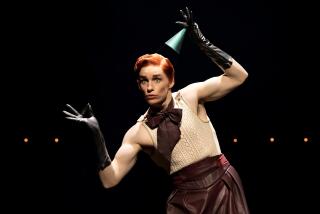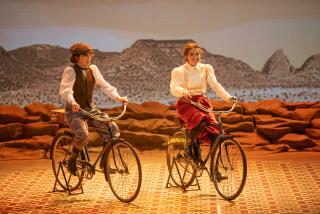‘Robin and the 7 Hoods’ revives Cahn and Van Heusen tunes

Of the following fabled songwriting teams of the 20th century, which won three Oscars, garnered eight Oscar nominations, but never won a Tony?
A) Richard Rodgers and Oscar Hammerstein II.
B) George and Ira Gershwin.
C) Alan Jay Lerner and Frederick Loewe.
D) Sammy Cahn and Jimmy Van Heusen.
If you picked “D,” well done!
For all their accolades, Cahn and Van Heusen lack a single Broadway hit -- their “Skyscraper” (1965) and “Walking Happy” (1966) faded fast --that showcases their sassy lyrics and engaging pop melodies.
Until now.
“Robin and the 7 Hoods,” opening Friday at the Old Globe, is a celebration of Cahn and Van Heusen at their catchiest, the score a late ‘50s-early ‘60s swing-a-thon. “Come Fly With Me,” “(Love Is) The Tender Trap,” “Come Blow Your Horn,” “My Kind of Town (Chicago Is),” “All the Way,” “High Hopes,” “Ain’t That a Kick in the Head” and more — a veritable soundtrack for the Rat Pack of the early 1960s: Frank Sinatra, Dean Martin, Sammy Davis Jr., Joey Bishop and Peter Lawford.
Of course, songs alone do not a good musical make. A story that entertains, acting that engages, and dancing that leaves ‘em gasping in the aisles would be helpful.
Enter Casey Nicholaw. The 48-year-old director-choreographer of “Robin and the 7 Hoods” is the man charged with generating all those components and bringing them together with the music.
To that end, he and his 23-member cast have been working hard since June 1 in basement rehearsal space at the Old Globe complex. Spend time there and good luck keeping up as Nicholaw darts into a line of dancers to tweak a step that wasn’t quite there or hurries off to block a scene so an actress’ shrieks will work to peak comic effect.
He caps off each creative interaction by saying a variation on “OK, that was great — I have just a couple of notes to go through with you,” and then the work busily resumes.
In the last few years, this focus and energy — manifestations of a confident creative sensibility — has propelled Nicholaw onto the short list kept by the theater management set who evaluate directing and choreographing skills. At the Ahmanson, during the run-up to “The Drowsy Chaperone” (2005) and “Minsky’s” (2009), Center Theatre Group Artistic Director Michael Ritchie got a close-up look and admired what he saw.
“At the early meetings and first rehearsal, Casey articulated absolute clarity of vision,” said Ritchie. “And then, as the work went forward, I witnessed someone who was never negative or a martinet — he generated an atmosphere of openness and collegiality in the room, and built on that to set a high level of expectation for those working for him.
“As long as I’m in this job, the Center will happy to be part of any project Casey wants to work with us on.”
Theatrical upbringing
Nicholaw was born in Santa Monica in 1962, but grew up in the San Diego area.
His early theater interests sprouted from familiar sources: a household with played-to-death cast albums of “My Fair Lady” and “The Music Man” (“I remember, too,” Nicholaw said, “being allowed to stay up late this one time to watch ‘Gypsy’ with Rosalind Russell on TV. A racy treat!”); a decade of youth theater involvement (“my first role I was a dancing Indian”); and seeing a life-altering performance (“Mom took me and a friend out of school on a Wednesday to the Schubert in Century City for a matinee of ‘ A Chorus Line.’ That was huge!”).
At 16 — too young by the theater’s regulations back then, but he fudged his age, claiming 18 — he won a role in an Old Globe production of “The Robber Bridegroom,” starring Brian Stokes Mitchell. “I was ‘Goat,’ and I had two songs, ‘Poor Tied Up Darlin’ and I can’t recall the other.” (Credit sheets indicate Goat also sings in “Once Upon the Natchez Trace.”)
In 1981, after a year and a quarter at UCLA, Nicholaw headed to New York. The do-everything ethos of a season of summer stock in New Hampshire saw him choreograph as well as dance and act; a decade or so worth of parts later, his first Broadway break came when choreographer Susan Stroman hired him into the corps of the splendid 1992 adaptation of Gershwin songs, “Crazy for You.” Nicholaw danced in seven Broadway shows, among them “Thoroughly Modern Millie” and “Victor/Victoria.”
All the time he paid attention.
“I’m not the big planner, I was just happy to get those jobs,” said Nicholaw. “But my whole life in shows, I kept watch on the choreographers and directors — what they did, what worked, what didn’t, what I would have done if I was them.”
In 2005 he choreographed on Broadway for the first time for “Monty Python’s Spamalot,” directed by Mike Nichols. A Tony nomination ensued. In 2006 he choreographed and also directed on Broadway for the first time, with “The Drowsy Chaperone.” Tony nominations for choreographer and director ensued.
Nicholaw’s assessment of choreographing dance for a musical is tactical: “Examine the steps, keep in mind what the dance needs to say, then fix the steps. Over all, I like dancing [in my shows to be] a little athletic, a little comedic and I really shoot for telling a story through the dancing.”
He describes his approach to directing in more strategic terms: “It’s being creatively critical all the time, through every detail, while never losing sight of the show’s bigger goals. I like doing the creative work more than the paperwork, but both is what the job takes. I think I’m best at urging talented people on and I never resent having to hold their hand sometimes.”
Lou Spisto, executive producer of the Old Globe, has a canny eye for talent and he appreciated Nicholaw’s longtime roots with the theater. So when the project became available, he was happy for the theater to present its first developmental run.
“Casey’s a homegrown guy and a top musical theater maker,” said Spisto. “We typically have one to two musically driven pieces a year here, ideally new works. With these songs and Casey, who really can drive a show, I felt it would be right for our audiences.”
Wary of source material
Like any other, this musical presents challenges. For instance, mention the source material from the original movie to the show’s principals and the responses vary from a shrug to a wince.
A 1964 Frank-Dino-Sammy vehicle, “Robin and the 7 Hoods” is short on “ring-a-ding-ding.” It’s two hours of stodgy gags, Chicago gangsters unaccountably speaking in New Yawk dese-dem-dose accents and the kind of wrongheadedness that sees Peter Falk given a livelier tune to sing than any that are going Bing Crosby’s way. Cahn and Van Heusen have to shoulder some of the blame — although there are only six of their songs in the movie (the new musical has 19), they actually add to the torpor rather than pepping things up. Only one, “My Kind of Town (Chicago Is),” remains in the new project, and it’s arranged at a noticeably brisker tempo.
As for the new story, “we’ve basically kept the title and the rogues with names from the Robin Hood tale, but that’s about all,” said Tony Award winner Rupert Holmes, who wrote the book for the musical.
Now the characters live in the early ‘60s and the men sport “Mad Men”-style suits instead of Depression-era fedoras. The costume design from Tony winner Gregg Barnes (another Old Globe alumnus from childhood on) shoots for sleek and snappy a la the early Kennedy/Camelot period.
“The story’s target is to serve the tone and style of these great songs,” said Holmes. “They’re breezy, upbeat. I promise this will not be a story with weighty insights into the inner psyches of Chicago mobsters — we’re here for a good time.”
“But not a cartoon-y thing,” chimed in Nicholaw, during a separate chat. “I want it to be buoyant. And sexy, it has to feel sexy. And have a musical theater quality to it, not just be a musical comedy.”
He laughed at the high bar he was setting, both during the conversation and in the rehearsals. “I know, I know, that’s a tough and narrow thing to find. Hopefully, we find it.
“The songs really cook,” Nicholaw said. “We’re aiming to cook too.”
More to Read
The biggest entertainment stories
Get our big stories about Hollywood, film, television, music, arts, culture and more right in your inbox as soon as they publish.
You may occasionally receive promotional content from the Los Angeles Times.






